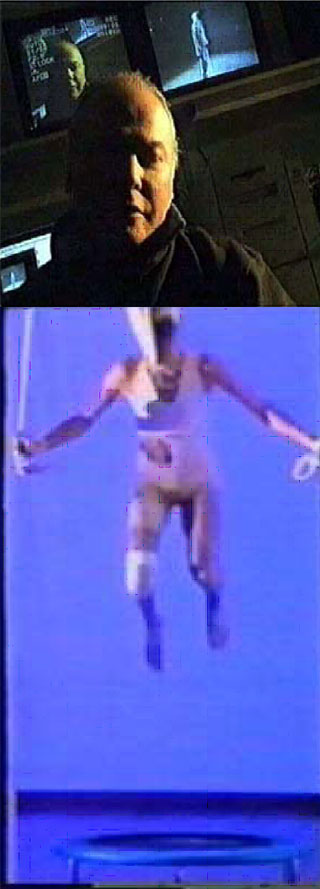 |
The Horizon of Events is the name of the theatrical work which provided Ezio Cuoghi with a starting point for an artistic research which runs across the boundaries between Art and Science, making it the essence of a new dramaturgical vision, which continues to bear its fruits.
In December 1993, in the Video Art Centre of Palazzo dei Diamanti (Ferrara), this sort of work in progress got off the ground, and one performance after another, lead to the latest event, realized in December 2003 in the Teatro Cavallerizza in Reggio Emilia. This above-mentioned work, called ‘Simultaneous Action', has witnessed a subsequent development of the multimedial dialogue introduced in the early nineties with the concept of Time.
Over these last ten years exactly there are things which have remained the same and things which have changed, above all thanks to the contribution of more sophisticated technology which has allowed further openings into new intermedial scenarios, even though it has continued to walk hand in hand with art and science, whose union represents the indissoluble and characteristic basis of the work which we are presenting here.
The contamination between art and science is suggested right from the title since, quoting the author: "...after all, one of the more immediate keys to reading into this work lies in the title: L'Orizzonte degli Eventi'. From the first the poetic, literary element of this title looms up, when in reality it is a typically scientific definition which serves to indicate that particular boundary line of a black hole at the confines of which the clock of a hypothetical traveller in space slows down his relentless running until he comes to a halt....".
Already in 1993 we were faced with the suggestive demonstration that demanding themes can be tackled with without in the meantime losing the great force of a spectacular performance, that is to say its ability to have an effect on the precious gifts of hearing, observation, attention and, if all goes well, of empathy. And putting on a show regarding an age-old concept like that of Time (Let's bring to mind the words of Sant'Agostino: "So what is time? If nobody asks me I know; if I wished to explain it to the person who asks me I don't know how to") is as difficult as it is fascinating, if it is a success like The Horizon of Events, whose strength lies in the fact that it uses as supporting axle philosophical and scientific theory, made explicit in the texts written by the physicist Franco Mezzetti ( "La misura del tempo", "La freccia del tempo", "Achille e la tartaruga"), to which literature, dance, theatre and art serve as a satellite, with a certain aesthetically pleasing result and an impression of total harmony on stage.
The subtitle of the performance/event is " from the concept of time: images, sounds, theories, rhythms, movements and words" and, indeed, in the eighteen episodes into which the work is divided, the concept of Time is unravelled through various actions, which range from the presence on stage of the "salame da tempo" ( seven jute sacks full of sand which are emptied in twelve minutes), a sort of sandglass to measure how long the performance lasts, set going at the right time by the dancer, to the actor reciting "La misura del tempo" while the dancer (Thierry Parmantier) dances on a platform in the shape of a half-moon "oscillating like a metronome", to the soprano (Barbara Lui) who sings the three most important relativistic formulas as regards time whilst Italo Calvino's "Le conchiglie e il tempo" is read and a large pendulum oscillates in the proscenium right until the end of the performance.
All of this enriched by the projection of symbols and words and by the filming and delayed reproduction (eighteen seconds later) on a plexiglass of the actor, by the signs/ drawings produced in real time by the visual artist Enzo Tinarelli, filmed carrying out his task by a telecamera which sends images to various monitors positioned among the audience, and by the stylistically varying types of music which attempt to satisfy the various "episodes"(from the Indian work "Mahabharata" to the tribal rhythms of the "Tambours du Bronx"). The Orizon of Events is a first indication that it is possible to make concrete, in aesthetically pleasing form, the stimuli and the suggestions which science offers, avoiding both the digression of a science-fiction story and the rigour of scientific diffusion.
Abstract
|